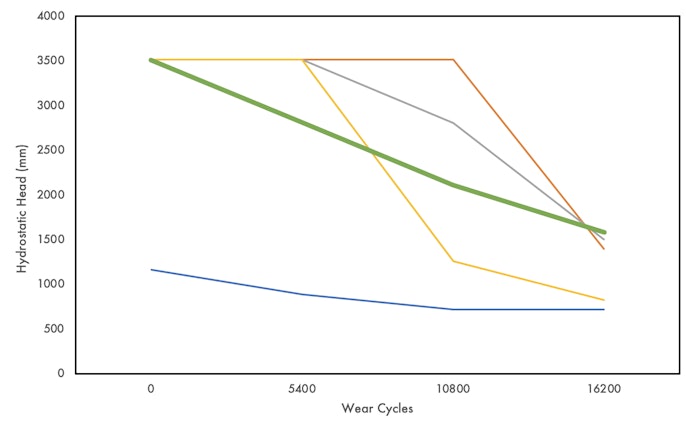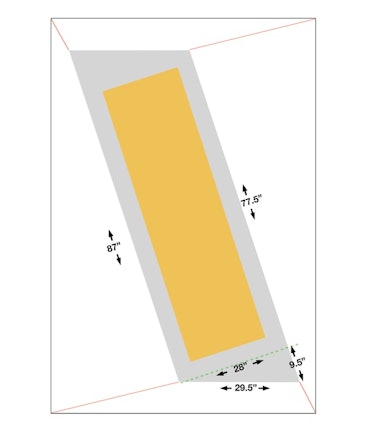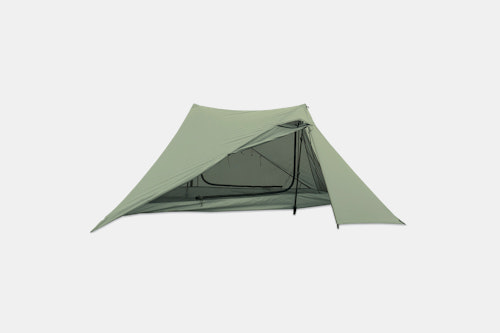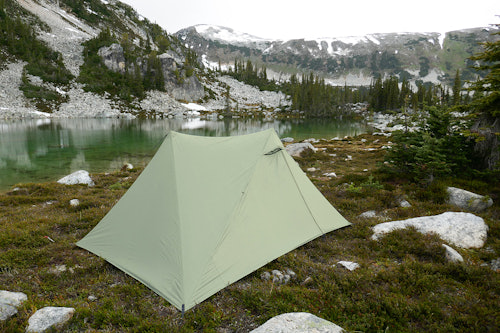Click to view our Accessibility Statement or contact us with accessibility-related questions
 VIEW 1 MORE
VIEW 1 MORE VIEW 3 MORE
VIEW 3 MORE














 VIEW 5 MORE
VIEW 5 MORE VIEW 3 MORE
VIEW 3 MORE
Drop + Dan Durston X-Mid 1P Tent
Drop + Dan Durston X-Mid 1P Tent
bookmark_border
Where's the price?
To negotiate the best possible price for our customers, we agree to hide prices prior to logging in.
4.2K requests
·
Free Returns in USA
Product Description
Designed to be the best double-wall solo shelter supported by trekking poles, the X-Mid is the brainchild of Dan Durston, an experienced thru-hiker and established member of the ultralight community. It aims to solve the common issues seen in trekking-pole-supported tents: Most are single-trekking-pole pyramids, which lack headroom, or overly complex multi-pole designs, which are tedious to pitch Read More
Want to know something about this product or how to use it?
Ask the community!
Ask the community!
Sort by: Newest
keyboard_arrow_downDarraghkilroy
1
Jun 18, 2020
Is 2000mm Hydrostatic Head enough, I thought the minimum rating was 3000mm to be considered "Waterproof" looks lovely, but that's a real worry

dandurston
5118
Dan Durston
Jun 19, 2020
Most tents provide the HH spec for the new fabric, but that's a nearly useless spec because waterproof coatings can wear dramatically such that the new spec tells you almost nothing about how the coating really holds up. Lots of coatings can test at 5,000 or even 10,000mm but they can also be very thin and easily abraded or cracked so they might only test at 500mm after a few weeks of use (imagine a super thin layer of plastic where it is very waterproof but also easily damaged vs something thicker).
Consider why so many rain jackets leak even with impressive 20,000mm specs. It's because the coatings/membranes are so thin or poorly impregnated that the coating degrades rapidly even though it was great when new. It's the same thing with tents, but instead of recognizing the problem (degrading coatings) people look for ever higher new specs .What you really want are coatings that last.
Because of this, with the X-Mid we provide the spec for heavily worn fabric. The new fabric actually tests much higher than 2000mm. I'm not sure how high because our testing maxes out at 3500mm, but it's higher than that. We wear test it to simulate years of use, and then unlike anyone else, provide the spec for that worn fabric since that more accurately represents how it will perform years down the road.
To illustrate that, here is a graph showing the HH of the X-Mid fabric (green) over time (machine generated wear cycles) against some popular competitors fabrics. Note that 3500mm is the max of the testing equipment, so results there are actually higher. A key point here is that several of these fabrics are higher than the X-Mid at the beginning (0 wear cycles) and would test at >5000mm, but all of them are lower than the X-Mid by the end because the X-Mid coatings are heavily impregnated.


(Edited)

rudiebln
45
Nov 20, 2019
Either get some hiking poles or some adjustable tent poles from another company. To me the hiking poles are so worth it. Apart from taking the strain off the knees when going downhill they prevent my hands from swelling on long hikes and you can use them to roll out the kinks and knots in your legs.
(Edited)

rudiebln
45
Nov 20, 2019
Super easy. Stake out a rectangle and then insert the poles, extend until taut. Eh voilà!

pgreenbaum
17
Jan 11, 2020
rudieblnI found it harder then expected. Getting that right angle is key. While knew it was not a free-standing, the stake outs are key, even my 6 Moons is more sturdy with one pole. After couple of tries, can now setup pretty quick.

ndrednek
22
Dec 16, 2019
First time, 10 minutes, you'll have to do it twice. After that probably 3 minutes. Best tent I have owned.
Xanthe
11
Dec 14, 2019
I am not good at these things, but I can get an ok pitch every time in under 5mins. Getting a right angle on the 3rd peg out is surprisingly hard, but there is tolerance in normal conditions for an imperfect pitch. It's by far the easiest and quickest tent I have pitched or put away, and good value and obviously light weight.
oldsparkey
70
Aug 8, 2020
I have a lot of tents in my 76 years and this has to be the easiest one to set up , especially after the 1st time when you have installed the screen area. When it's in and you leave it that processes is done. Dan has a video on YouTube about how to do it.
https://www.youtube.com/watch?v=cVboRcwY6P0&t=130s

J.D.Lee
Dec 16, 2019
Watch the videos, then practice a few times. It takes some finessing, but once you get the insert in it's easier to sort. My biggest issue was getting over the mental hurdle that the insert isn't going to sit inside like you think it will - it's going to be a bit of an angle. Practice is going to be the best option to getting it down. I also don't remove the insert when I break it down, so there's one less thing I have to try and sort when putting it up again. I fold the insert into the middle and fold the rest of the tent around it so that the mesh stays protected.

Ogredx2
6
May 24, 2020
Set up especially with you tube videos by Dan as well as others tell you how, 2-3 setups in backyard make it easy to learn. Take the 30-45 mins in back yard to set it up a few times before heading out. Good advice for most gear tbh.
DXRDC
10
Dec 19, 2019
It is easy check you tube there are plenty of show all videos just need trek poles or some alternative lit of vestibule space for a one person tent
LightDan
22
Dec 17, 2019
Very easy to set up.
If there is going to be some wind, snow and/or heavy rain during the night, use the guy lines on the top, I have the tent sag slightly under some wet snow, it was still dry and warm inside, but I lost a few inch of height and lenght of the inner tent.
If in any doubt, use the guy lines, it will never hurt, but it will sometimes help.

jesse1time
2
Dec 16, 2019
Even if your rectangle is off after a long day the middle just sags a bit and the tent is still great to sleep in
HoosierVolunteer
6
Dec 16, 2019
It’s the easiest trekking pole tent to set up. This is because the shape is a rectangle and not some “funky” geometry. After a the first few times setting it up you should be able to do it in 5 minutes or less.

jazz_chi
16
Sep 4, 2020
HoosierVolunteerThe only tricky bit to that rectangle is site selection. Since the inner is diagonal relative to the overall footprint, you have to angle your set-up so that you sleep along the fall-line of a slope instead of diagonal. With a couple nights, this becomes second nature. Also, the footprint is more like a standard 2P tent, so that impacts site selection as well.

lcsitl
2
Mar 12, 2020
It's pretty easy, especially after doing it once or twice. It's also easy to fiddle with it after it's basically up to make it exactly perfect. I usually tighten everything up once it's pitched by relocating any stakes slightly as necessary, and pushing each pole up a smidge higher from their initial pitch. I've had no problems with it in lots of wind (though I did once because the short stakes pulled right out of FL sand. Now that I have more appropriate stakes, I can set it up really quickly and it feels super sturdy, even in lots of wind and rain.

Randy1h
1
Nov 5, 2020
rlhydnI found setup to be exceptionally easy. I tested a few times in the backyard (as someone mentioned earlier in this thread) so camp setup was and is a snap, 2-3 minutes tops. Probably what I've spent the most time with is being maximally efficient in take down and repacking. That bit is not at all difficult, I just try to eliminate wasted motion and repack in the fewest possible movements.
BenjaminZac
1
Apr 6, 2020
How well does this tent stand up to rain and wind? I am in Scotland where it rains alot and storms can whip up from no where. Don't want to be flying a kite instead of being tucked inside nice a cosy and dry.

dandurston
5118
Dan Durston
Apr 7, 2020
The X-Mid is truly designed to be very weather capable and not merely hyped as such, so it has genuinely useful features like a full coverage fly that extends to the ground (to block wind and rain splatter), fly first pitch (to keep the inner dry) and lots of other harsh weather capable features like dual large vents (that can shut to block wind and spindrift), peak guylines (to better anchor it high winds), protected entryways (so rain doesn't drip on the floor), thick waterproof fabric coatings (posted HH specs are after wear testing, which is far more rigorous than the new fabric specs other use) etc. The X-Mid is as good as it gets for rain performance in a 3 season tent. It's not a 4-season tent for 100km/hr winds but lots of folks over the UK and Scotland are using them successfully in pretty stiff winds.
(Edited)

dandurston
5118
Dan Durston
Mar 31, 2020
I recommend just covering the floor of the tent and not the vestibules. That's lighter and avoid risk that the groundsheet creeps out from under the fly and collections. Below are the dimensions you need. Both ends are the same (aside from being a mirror image).








